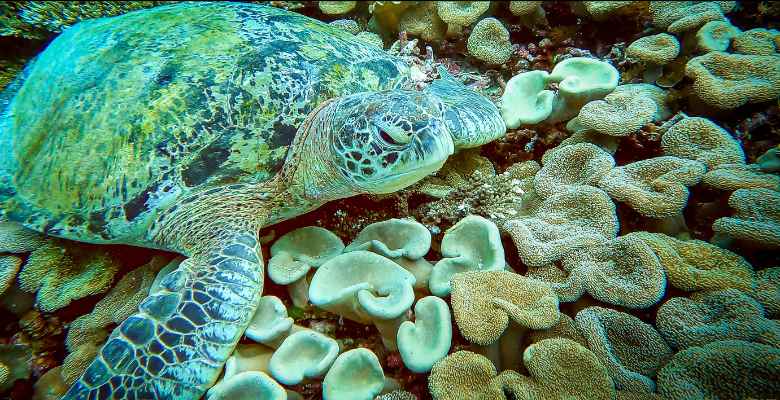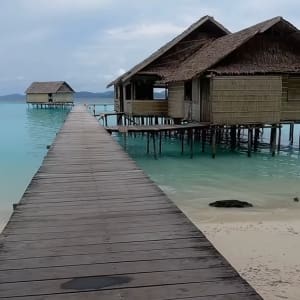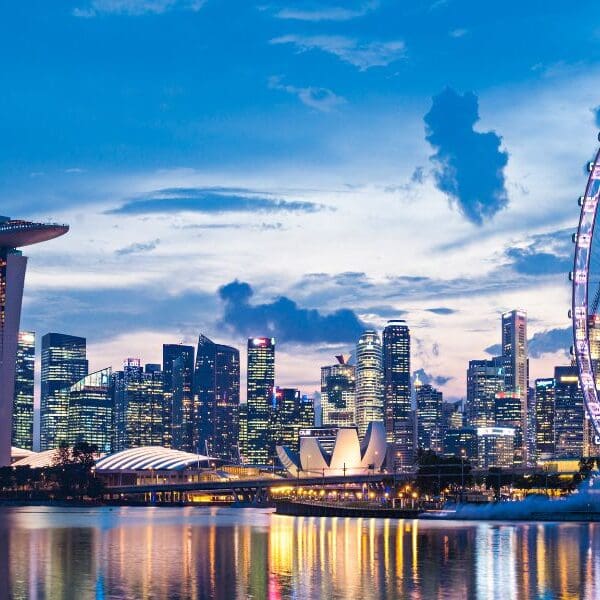Last Updated: November 13, 2024

When we ticked off John’s retirement travel bucket list item of seeing Komodo dragons at Komodo Islands, we really thought that we’d gone to paradise. And then we came to Raja Ampat, Indonesia.
An archipelago of over 1,500 islands, situated in the heart of the Coral Triangle (the planet’s richest center of marina life and coral diversity), Raja Ampat is a haven of unrivaled beauty and biodiversity, famed as one of the world’s best diving sites. Travelers fascinated with underwater life or those looking to completely disconnect from the world should look no further! A visit to Raja Ampat is a nature-immersive experience, full of diving, snorkeling, hiking, and simply being one with your paradisiac surroundings.

It’s hard to imagine a place so awe-inspiring. A place where words and pictures alone cannot capture the true essence. Raja Ampat truly is the last paradise on Earth. Getting there is no walk in the park, but our journey forever altered our perception of natural wonders, and we left with a profound appreciation for Earth’s remarkable treasures. So if you are planning a trip to Indonesia, we’ve put together this travel guide to Raja Ampat in hopes of convincing you to visit this remote corner of the world.
Is Raja Ampat Worth Visiting?
When researching Raja Ampat, we read over and over again that Raja Ampat diving is the best in the world. Although we are not divers, but avid snorkelers, it made perfect sense for us to undertake the difficult journey and tick off another bucket list experience. And thanks to its remote location, it remains one of the last unspoiled and uncrowded aquatic paradises in the world.


Local waters have the highest concentration of marine biodiversity in the world, estimated at over 75% of the world’s population of coral species and over 6,000 species of fish. A Raja Ampat tour will introduce you to massive congregations of fish, turtles, sharks, manta rays, and vibrant coral reefs. Above the surface, you will marvel at lagoons of incredible colors and limestone cliff formations, creating a breathtaking landscape.
A stay in Raja Ampat offers unparalleled relaxation when all worries are shadowed by the beauty of nature. Trips like that really put life into perspective. So, do you think Raja Ampat is worth it?
Getting to Raja Ampat
How to get to Raja Ampat is a popular question due to its remoteness. And it’s no easy feat, but the effort comes with high rewards and also helps keep a cap on the number of tourists willing to visit, thus conserving the environment. Most visitors will arrive by plane to Sorong, which is situated in West Papua province in Indonesia and receives regular flights from Jakarta. This is the same route we decided to take, first making our way from Bali to Jakarta, then hopping on an overnight flight to Sorong, followed by a ferry ride to Waisai Harbor. The ferry, although not luxurious despite paying $10 extra for the VIP section, has all the facilities you need. The extra fee gave us a sofa and air conditioning so we could sleep in comfort after the exhausting journey. We didn’t even get to try out the snacks.



Tip: Since there are a few flights and ferries to Raja Ampat, you have to carefully stack your itinerary to avoid missing the next leg. Otherwise, you may be stuck waiting until the next day!
Arriving in Waisai Harbor
Upon arrival at Waisai Harbor, we made our way to the tourist center to register. In order to manage and conserve Raja Ampat Marine Park, all international and Indonesian citizens are required to register and pay an Environmental Service fee (approximately $47) and a visitor fee (approximately $20). Upon completion, you get a Marine Park Entry card, which you should have on you during the entire stay to present in case of patrols.
The last leg of the journey is a speed boat to your accommodation, which should be arranged in advance. Our boat ride was about an hour long and resembled the ride to our dreamy villa on Lake Atitlan, Guatemala, only this boat had cushions instead of seats. And the final destination was a patchwork of emerald islands.
Accommodations in Raja Ampat

At a glance, Raja Ampat accommodation is rustic and not the most budget-friendly. Most bungalows are pretty basic, with a fan in place of air conditioning and limited electricity. But upon closer inspection, you realize that you are getting good value for your money. Firstly, the majority of resorts include three meals a day for two in the room rate. Secondly, your bungalow is most likely water-facing, and that view is priceless. So we promise you, you are not going to care for the lack of AC. And the patchy Wifi is just another opportunity for you to disconnect!

There are also liveaboard dive boats that offer accommodation of various standards if you are looking to add more adventure to your trip. Whichever option you choose, we recommend booking in advance due to limited availability.
In our case, we booked a four-night stay with Wai Resort at $312 per night, which was a splurge. When booking accommodation, we felt Wai Resort stood out among others. And it turned out to be one of our favorite places on Earth so far. The resort is located on a private island and has only 7 bungalows that are all ocean-facing. With a capacity of 14 people, we were two out of the only four guests on the island, our meals were delicious, and the staff was attentive. So you can see why the price is justified. Although, the elevated prices, which are set due to remoteness, also play a role in preventing overcrowding, preserving the feel of exclusivity of Raja Ampat.


We are planning to return and will stay at the Nyande Raja Ampat Resort. It is only $125 per night and came highly recommended from some fellow travelers. We will let you know what we thought.
Activities in Raja Ampat
While getting to Raja Ampat was challenging, being there was way too easy. After having spent the last two months of our Southeast Asian adventure touring busy cities, we couldn’t get enough of our simple yet indulgent routine in Raja Ampat. The beaches were powder-white, the water was the clearest we’d ever seen, and the sky was endless. And we got to wake up to this scene every day of our short stay in Raja Ampat, in a bungalow just 30 feet from the water’s edge. We had to pinch ourselves to make sure we weren’t dreaming.
Your Own Private Resort Island
The advantage of sharing the private island with only two other people was soaking in the quietness, except for the unique birds and lapping waves that serenaded us all day. We indulged in a couple’s massage where we were hypnotized by fish lurking in water beneath us, instead of staring at the floor. Naturally, luxurious pastimes like this resulted in incredible naps!


Beneath the surface of Raja Ampat’s cerulean waters lies a hidden world of extraordinary diversity, which we frequented any chance we got. We snorkeled in front of our bungalow and took boat trips with the resort boat crew to dive spots. While snorkeling around our private island was magical, we quickly learned that it’s nothing compared to the giant schools of fish and marine creatures of all sizes and colors that we saw at other diving spots. Never have we seen so much marine biodiversity in a single dive.
Exploring our Island


On another day, we took a guided tour of our island with a team member of the resort to get the lay of the land and stumbled on a colony of flying foxes that looked like huge bats hanging in the trees. They migrate from island to island, looking for food and hanging out the rest of the time – the typical Raja Ampat lifestyle that we, too, picked up in no time! Our guide told us to sit on the dock at sunset to watch the flock of foxes fly over us on their way to hunt for food, which was a beautiful spectacle to watch right before our own meal time. Perfectly in sync with nature.
Our Video from Raja Ampat
This video is our experience in one of the world’s most perfect travel destinations, Raja Ampat, Indonesia. This very remote location full of white sand beaches which happens to be the best snorkeling and diving spot in the world. It’s the one place left that isn’t overrun by tourists. It is so much more affordable than Bora Bora or the Maldives, with much less people, and it’s more beautiful under water. It’s a little hard to get to, but we’re going to share with you how to get to this remote paradise, including flight information and ferry service. We’ll also show you the resort we stayed in and how you can book this hidden gem.
Other General Raja Ampat Travel Tips:
Plan your itinerary:
Determine the duration of your trip and the specific islands or areas of Raja Ampat you want to visit. Consider the activities you wish to engage in, such as snorkeling, diving, or exploring the local culture. Obtain necessary travel documents: Ensure your passport is valid for at least six months beyond your planned departure date. Check the visa requirements for your country of residence. Indonesia offers visa-free entry or visa-on-arrival for many nationalities, but it’s best to confirm this before your trip.

Choose your travel dates:
Raja Ampat’s weather is typically warm and tropical year-round. The dry season, from October to April, is generally recommended for better visibility in the water. However, the islands are accessible throughout the year.
Book your flights:
The main entry point to Raja Ampat is Sorong, located in West Papua, Indonesia. Search for flights to Domine Eduard Osok Airport (SOQ) in Sorong. Several airlines operate regular flights from major Indonesian cities like Jakarta, Bali, or Makassar. From Sorong, you will need to take a ferry or speedboat to reach the islands.
Raja Ampat Accommodations:



Raja Ampat offers various types of accommodation, ranging from budget-friendly homestays to luxury resorts. Research and book your accommodation in advance to secure your preferred options, especially during peak seasons.
Dive into Raja Ampat’s underwater paradise:
This part of Indonesia is renowned for its unparalleled marine biodiversity. It provides the best snorkeling and diving in the world. Engage in snorkeling or scuba diving activities to explore the vibrant coral reefs. You will encounter colorful fish species, and possibly spot manta rays and sea turtles. Numerous dive centers and operators are available across the islands.

Respect the environment and local communities:
Raja Ampat, Indonesia is an ecologically sensitive area with fragile ecosystems. Follow responsible tourism practices by not littering, avoiding stepping on coral, and using reef-safe sunscreen. Respect the local culture and traditions, and support the local economy by purchasing locally made products.
Best Time to Visit Raja Ampat, Indonesia
We have linked a great website to this button showing the weather for this location by the month. Click below to be taken to Weather-and-Climate.com.







Joann
Loved your video and travel information. We (my husband and three other couples) have booked two weeks on a dive/snorkel liveaboard in Raj Ampat. We want to do some other travel in the area. We’ll probably fly to Jakarta and take that route to Sorong. Can you recommend other places to visit that would be in the region, or in Jakarta? We are all retired, as you are, and are avid swimmer/snorkelers. Thanks!
Retirement Travelers
Joann, So glad you are enjoying our channel. On our visit we only went to Raja Ampat, Bali, and Komodo. We enjoyed all 3, but know there is so much more in Indonesia. We would encourage you to join our Facebook group (forum) called Retirement Travelers Community for Senior World Travel. Post a photo and ask this same question. There are now 3400 people in the group and anyone who has been there might share some good ideas with you. It has been a very helpful and supportive group and growing everyday. Happy journeys and hope you have an amazing trip. John and Bev
Inge Vonderhott
Great post about Raja Ampat! The place sounds like a true piece of paradise and your experiences were well captured. Quick question – how tricky is it to get there for someone who hasn’t traveled much in Southeast Asia? Also, I came across a website that talks about prices globally: https://world-prices.com/en/indonesia/prices. I wonder if the info is up-to-date, though. Nonetheless, your article makes Raja Ampat seem worth every effort!
Retirement Travelers
Thanks for sharing. Not easy getting there. You must take an overnight flight from Jakarta to Sorong and then take a couple of ferries/boats to your final destination. The good news is that it isn’t overcrowded.
Happy journeys,
John and Bev